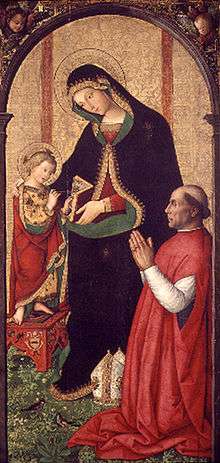Francisco de Borja
- Not to be confused with Saint Francis Borgia nor Francisco de Borja Echeverría, nor with Francisco Lloris y de Borja.

Francisco de Borja y Navarro de Alpicat (1441 – November 4, 1511) was a Spanish cardinal, and the seventh of ten cardinal-nephews created by Pope Alexander VI.
Biography
Borja was born in 1441 in Játiva, Spain and was a canon in the cathedral chapter of Valencia. After the election of Rodrigo Borja as Alexander VI by the papal conclave, 1492, Francisco went to Rome, becoming the protonotary apostolic, and then the treasurer general on September 20, 1493. He was elected bishop of Teano on August 19, 1495 and retained the see until June 5, 1508 when he resigned in favor of his nephew of the same name. There is no evidence he was ever consecrated. Alexander VI elevated Francisco as a cardinal priest on September 28, 1500 in pectore and published his cardinalate on October 2 adding the title of S. Cecilia on October 5.[1]
He later accumulated a variety of additional benefices: first as Abbot commendatario of the monasteries of S. Vincenzo, Volturno, and of S. Stefano di Sermo, then the diocese of Terracina on August 19, 1495, and then the metropolitan see of Cosenza on November 6, 1499.[1]
He was made papal legate to Campagna in 1501, and left Rome on June 22 to retake Rocca di Papa and other estates of the Colonna for the papacy. In 1502, he followed Lucrezia Borgia to Ferrara for her marriage to Alfonso d'Este, and became tutor to Alexander VI's youngest son, Gioffre Borgia.[1]
From January 1503 to 1504, Borja held the title of Camerlengo, and during that time on March 10 he attempted to recover some debts owed to the College of Cardinals. He participated in the papal conclaves of September and October 1503, before gaining the title of Ss. Nereo ed Achilleo on August 11, 1506.[1]
Along with other cardinals, Borja plotted against Pope Julius II, and from Ferrara, published in opposition to the pontiff. His signature is also affixed to the document dated March 16, 1511 which attempted to bring the pope to a council in Pisa; Borja delegated his authority in absentia to the five other cardinals who attended the council. As a result, Borja was deprived of his cardinalate and excommunicated by Julius II on October 24, 1511. The other councilars—Cardinals Federico di Sanseverino, Bernardino López de Carvajal, Guillaume Briçonnet, René de Prie, and Amanieu d'Albret (another cardinal-nephew of Alexander VI)—were also excommunicated, but unlike Borja they lived long enough to be pardoned and have their cardinalates reinstated in 1513 by Pope Leo X. Before death, Borja was briefly protoprete from January 1511, dying on November 4, 1511 in Reggio Emilia (where he is buried) before having had the opportunity to learn of his excommunication.[1]
See also
Notes
|